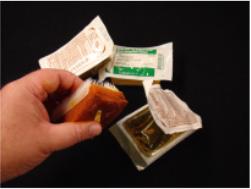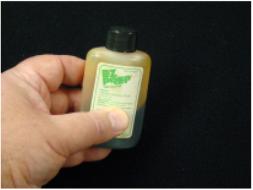|
Section III: Cleansing Agents in Use
1-11. INTRODUCTION
A number of surgical soaps are available for use in Army hospitals. Scrub brushes are also used. A surgical scrub brush/sponge with a nail cleaner are prepackaged, presterilized, and may be impregnated with a surgical soap. The brush is disposable and for one time use only.
1-12. SURGICAL SOAPS
a. Standard Agents. The surgical soaps available as a standard item are Povidone-iodine and Hibiclens®. These soaps are used in a concentrated liquid form in soap dispensers or in brushes impregnated with these detergents.
b. Desirable Properties. These agents are preferable for doing the surgical scrub because:
(1) They are nonirritating to most people.
(2) They leave a minimum number of microorganisms on the skin.
(3) They have a prolonged anti-bacterial effect on the skin when used
regularly. Surgical detergents leave a film on the skin which keeps the resident bacteria to a minimum and yet they do not interfere with the skin's natural resistance to transient bacteria (refer to paragraphs 1-1d(1) and (2)).(4) They will lather in either hot, cold, or hard water.
(5) The amount of detergent needed for a scrub is small (about 8 ml). Adding more water produces more lather.
1-13. ALTERNATIVES IN THE FIELD
a. Povidone-iodine and Hibiclens are two types of surgical soaps that are available as standard items. These soaps are in liquid form.
b. When surgical soaps are not available, the surgical scrub should be performed according to local standard policy.
|
|||||||||
|
LESSON OBJECTIVES After completing this lesson, you should be able to: 1-1. Select safe, effective procedures and techniques for performing a surgical scrub and donning sterile gown and gloves. 1-2. Assist other members of the "sterile" team in donning gown and gloves. 1-3. Select appropriate procedures for removing gown and gloves between cases. |
|||||||||
The Brookside Associates Medical Education Division is dedicated to the development and dissemination of medical information that may be useful to medical professionals and those in training to become medical professionals. This website is privately-held and not connected to any governmental agency. The views expressed here are those of the authors, and unless otherwise noted, do not necessarily reflect the views of the Brookside Associates, Ltd., any governmental or private organizations. All writings, discussions, and publications on this website are unclassified.
© 2008 Medical Education Division, Brookside Associates, Ltd. All rights reserved

